Archive:European Neighbourhood Policy - East - tourism statistics
- Data extracted in September 2014. Most recent data: Further Eurostat information, Main tables and Database. Planned article update: October 2015.
This article is part of an online publication and presents information relating to tourism in the European Union (EU) and the six countries that together form the European Neighbourhood Policy-East (ENP-E) region, namely, Armenia, Azerbaijan, Belarus, Georgia, Moldova and Ukraine. It highlights recent developments over the period 2003–13, with information on the number of bed places, the number of arrivals of non-residents at hotels and similar accommodation (NACE Rev. 2 Group 55.1) and the number of outbound trips made by tourists.

(thousands) - Source: Eurostat (enpr_intour) and (tour_cap_nat)
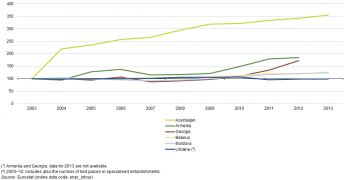
(2003 = 100) - Source: Eurostat (enpr_intour)
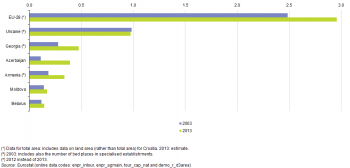
(number of bed places per km² of total area) - Source: Eurostat (enpr_intour), (enpr_agmain), (tour_cap_nat) and (demo_r_d3area)
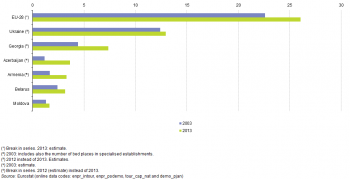
(number of bed places per 1 000 inhabitants) - Source: Eurostat (enpr_intour), (enpr_psdemo), (tour_cap_nat) and (demo_pjan)

(thousands) - Source: Eurostat (enpr_intour) and (tour_occ_arnat)

(2003 = 100) - Source: Eurostat (enpr_intour)

(arrivals of non-residents per bed place) - Source: Eurostat (enpr_intour), (tour_occ_arnat) and (tour_cap_nat)
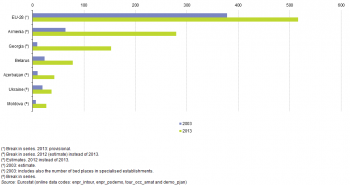
(arrivals of non-residents per 1 000 inhabitants) - Source: Eurostat (enpr_intour), (enpr_psdemo), (tour_occ_arnat) and (demo_pjan)

(thousands) - Source: Eurostat (enpr_intour) and (tour_dem_tttot)
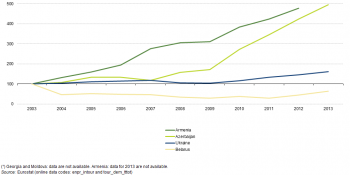
(2003 = 100) - Source: Eurostat (enpr_intour) and (tour_dem_tttot)
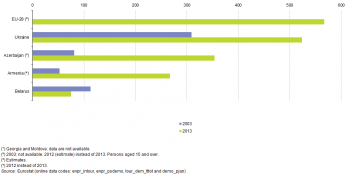
(average number of trips per 1 000 inhabitants) - Source: Eurostat (enpr_intour), (enpr_psdemo), (tour_dem_tttot) and (demo_pjan)
Main statistical findings
There were 700 thousand bed places in hotels and similar establishments across the ENP-East countries, the vast majority of which were in Ukraine
The number of bed places available in hotels and similar establishments provides one measure of a country’s capacity to attract tourists; note that official tourism statistics include business travellers as tourists alongside individuals travelling for pleasure or other reasons. The six ENP-East countries had a combined total of 700 thousand bed places (the latest information for each country relates to 2012 or 2013). By comparison, there were 13.2 million bed places in hotels and similar establishments in the EU-28 in 2013.
Among the ENP-East countries, Ukraine had by far the highest number of bed places in hotels and similar establishments, almost 590 thousand in 2013, which equated to almost 85 % of the total number of bed places available within the six ENP-East countries. In Azerbaijan, Belarus and Georgia (latest data are for 2012) there were between 30 and 35 thousand bed places, while there were 10 thousand bed places in Armenia (2012 data) and 6 thousand in Moldova (see Table 1).
The number of bed places grew in five of the six ENP-East countries during the period 2003–13
Figure 1 provides information on the development of the number of bed places in hotels and similar establishments over the period 2003–13. There was almost no change in the number of bed places in the ENP-East country with the highest number of bed places — Ukraine — while the remaining five ENP-East countries reported a marked expansion in their bed capacity; there was also an increase in the number of bed places in the EU-28 during the period 2003–13.
Among the ENP-East countries, the fastest expansion in bed places was recorded in Azerbaijan, where the number of places more than trebled between 2003 and 2013, while it almost doubled in Armenia and Georgia; note that the increases in the latter two countries occurred almost exclusively at the end of the time series during the period 2010–12.
Figure 2 presents an alternative measure for analysing the number of bed places in hotels and similar establishments, presenting this information in relation to the total area of each country. It shows that there was a higher density of bed places per square kilometre (km²) in the EU-28 than in any of the six ENP-East countries. Indeed, with an average of 3.0 bed places per km² in 2013, the EU-28 had a ratio that was approximately three times as high as that in Ukraine, which posted the highest density among the ENP-East countries (1.0 bed places per km² in 2013).
A final analysis of the number of bed places is presented in Figure 3: it compares the number of bed places in hotels and similar establishments to the number of inhabitants in each country. Using this measure, the EU-28 again recorded a higher capacity of bed places than any of the ENP-East countries. There were, on average, 26 bed places in hotels and similar establishments per 1 000 inhabitants across the EU-28 in 2013. This was more than double the ratio recorded in Ukraine (12.9 bed places per 1 000 inhabitants), 3.5 times as high as in Georgia (data are for 2012), 7–8 times as high as in Azerbaijan, Armenia (data are also for 2012) and Belarus, and 16 times as high as in Moldova. Among the ENP-East countries, the fastest expansion in the number of bed places per 1 000 inhabitants between 2003 and 2013 was recorded in Azerbaijan, where this ratio rose from 1.2 to 3.6 bed places.
Approximately 4.4 million non-residents arrived in hotels and similar establishments in the ENP-East countries
There were approximately 4.4 million annual arrivals of non-residents in hotels and similar establishments across the six ENP-East countries (the latest data relates to either 2012 or 2013). This figure could be compared with a total of 262 million arrivals of non-residents at hotels and similar establishments in the EU-28 in 2013 (see Table 2).
The information presented in the previous section showed that the number of bed places available in hotels and similar establishments in the six ENP-East countries was equivalent to 5.3 % of the EU-28 total. A similar comparison shows that non-resident arrivals in the six ENP-East countries were equivalent to 1.7 % of the EU-28 total. Indeed, the EU is a major tourist destination, according to the United Nations World Tourism Organisation, five EU Member States (France, Spain, Italy, Germany and the United Kingdom) were among the world’s top 10 destinations in 2013 — both in terms of tourist arrivals and international tourism receipts.
Figure 4 shows the development of the number of arrivals of non-residents staying in hotels and similar establishments during the period 2003–13. There was an increase in the number of arrivals of non-residents in the six ENP-East countries, all with growth rates above the 42 % overall increase recorded for the EU-28 between 2003 and 2013. The fastest expansion in the number of arrivals of non-residents was recorded in Georgia, where there was an 18-fold increase between 2003 and 2012. Although much slower, the pace of growth was nevertheless considerable in Armenia (latest data are for 2012), Azerbaijan and Moldova, as the number of non-resident arrivals increased 4- or 5-fold between 2003 and 2013.
An alternative analysis is presented in Figure 5: it presents the number of non-resident arrivals in hotels and similar establishments per bed place. Across the EU-28, this ratio averaged 19.8 in 2013, while higher ratios were recorded in Armenia (data are for 2012), Belarus and Georgia (data are also for 2012). The ratio of non-resident arrivals to bed places increased in the EU-28 and each of the six ENP-East countries, between 2003 and 2013.
Figure 6 shows the number of arrivals of non-residents in hotels and similar establishments relative to the number of (resident) inhabitants. In the EU-28 there were 517 arrivals of non-residents per 1 000 inhabitants in 2013; this marked an increase of 37 % when compared with the same ratio for 2003. Among the ENP-East countries, the ratio of non-resident arrivals to population was systematically lower than in the EU-28. The highest value was recorded for Armenia, with 279 non-resident arrivals per 1 000 inhabitants in 2012, while there were less than 100 non-resident arrivals per 1 000 inhabitants in Belarus, Azerbaijan, Ukraine and Moldova. However, the number of non-resident arrivals relative to population increased at a faster pace in each of the ENP-East countries than in the EU-28. The largest gains were recorded in Georgia, as this ratio increased 17-fold between 2003 and 2012.
The number of outbound trips taken by tourists reached 23.8 million in Ukraine in 2013
This final section details the outward flow of tourists travelling abroad. EU-28 tourists made 287 million trips to destinations outside the EU in 2012; note that EU-28 data for this particular indicator only refer to persons aged 15 and over.
By contrast, among the four ENP-East countries for which data are available (no information for Georgia or Moldova) the highest number of outbound trips taken by tourists was recorded for Ukraine — the most populous of the ENP-East countries — at almost 24 million in 2013. There were just over three million outbound trips made by tourists from Azerbaijan in 2013, while the number of outbound trips made from Armenia (data are for 2012) and Belarus was below one million (see Table 3).
Developments for the number of outbound tourist trips between 2003 and 2013 are shown in Figure 7. There was a rapid expansion in the number of outbound tourist trips from Armenia (2003–12) and Azerbaijan; for the latter, the growth in outbound tourist trips was particularly rapid from 2010 onwards. The same was true to some degree for Ukraine, where having posted almost no change in outbound tourism during the period 2003–09, there was a marked increase in the number of outbound tourist trips between 2010 and 2013. By contrast, the number of outbound trips made by tourists from Belarus fell considerably between 2003 and 2011, before recovering somewhat in 2012 and 2013 (although it remained more than 35 % below its level in 2003).
Figure 8 presents the number of outbound trips taken by tourists relative to the national population. In the EU-28 there were, on average, 567 trips per 1 000 inhabitants in 2012; note that the tourist trip figures relate to persons aged 15 and over.
Ukraine recorded the highest number of outbound trips per 1 000 inhabitants among the ENP-East countries, at 524 trips in 2013. This was considerably higher than the number of trips made from Azerbaijan (353 per 1 000 inhabitants)) or Armenia (267; data are for 2012), while the ratio of the number of trips made by outbound tourists relative to national population was considerably lower in Belarus (75).
Data sources and availability
Tourism, in a statistical context, refers to the activity of visitors taking a trip to a destination outside their usual environment, for less than a year. It can be for any main purpose, including business, leisure or other personal reasons other than to be employed in the place visited. A tourist is a visitor that stays overnight (at least one night).
Within the EU, a system of tourism statistics was established through Council Directive 95/57/EC of 23 November 1995 on the collection of statistical information in the field of tourism. This legal basis requires EU Member States to provide a regular set of comparable tourism statistics. Following amendments in 2004 and 2006, the European Parliament and the Council of the European Union adopted Regulation 692/2011 concerning European statistics on tourism in 2011 (repealing Council Directive 95/57/EC).
Tourism statistics in the EU consist of two main components: on the one hand, statistics relating to capacity and occupancy (supply side tourism statistics); on the other, statistics relating to tourism demand. In most EU Member States, the former are collected via surveys filled in by accommodation establishments, while the latter are mainly collected via traveller surveys at border crossings or through household surveys. Statistics on tourism demand refer to tourist participation, in other words, trips of at least one overnight stay during the reference period.
The data for ENP-East countries are supplied by and under the responsibility of the national statistical authorities of each country on a voluntary basis. The data result from an annual data collection cycle that has been established by Eurostat. These statistics are available free-of-charge on Eurostat’s website, together with a range of additional indicators for ENP-East countries covering most socio-economic topics.
Context
Tourism has the potential to contribute towards employment and economic growth, as well as to development in rural, peripheral or less-developed areas. Infrastructure created for tourism purposes contributes to local development, while jobs that are created or maintained can help counteract industrial or rural decline. Sustainable tourism involves the preservation and enhancement of cultural and natural heritage, ranging from the arts to local gastronomy or the preservation of biodiversity.
In cooperation with its ENP partners, Eurostat has the responsibility ‘to promote and implement the use of European and internationally recognised standards and methodology for the production of statistics necessary for developing and monitoring policy achievements in all policy areas’. Eurostat undertakes the task of coordinating EU efforts to increase the statistical capacity of the ENP countries. Additional information on the policy context of the ENP is provided here.
See also
- All articles on international statistical cooperation
- All articles on non-EU countries
- European Neighbourhood Policy countries - statistical overview (online publication)
Further Eurostat information
Publications
- Basic figures on the European Neighbourhood Policy — East countries — 2014 edition
- European Neighbourhood Policy — East countries — Key economic statistics — 2014 edition
- European Neighbourhood Policy — East countries — Labour market statistics — 2014 edition
- European Neighbourhood Policy — East countries — Youth statistics — 2014 edition
Database
- Industry, trade and services (enpr_in)
- ENP countries: tourism (enpr_intour)
- Tourism data (tour), see:
- Monthly data on tourism industries (tour_indm)
- Annual data on tourism industries (tour_inda)
- Annual data on trips of EU residents (tour_dem)
Dedicated section
Methodology / Metadata
- Eastern European Neighbourhood Policy countries (ENP-East) (ESMS metadata file — enpr_esms)
- Capacity and occupancy of tourist accomodation establishments (ESMS metadata file — tour_occ_esms)
- Annual data on trips of EU residents (ESMS metadata file — tour_dem_esms)
- Methodological manual for tourism statistics — version 2.1 — 2013 edition
Source data for tables and figures (MS Excel)
External links